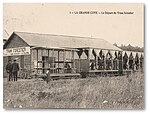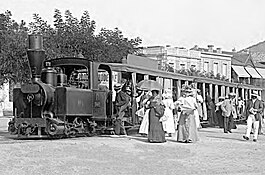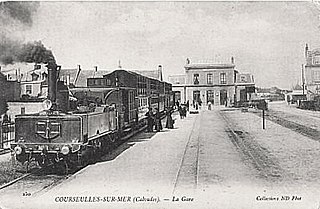| Photo | Station | Comment | More
photos |
|---|
| Stations of the forest tram line |
|---|
 | Ronce-les-Bains | Ronce-les-Bains was the northern terminus of the forest railway. From there it was possible to take a boat to the Île d'Oléron. [9] [10] | More
photos |
 | To La Tremblade | The Tramway forestier (normally spelt with a capital 'T' and a small 'f') was extended to the road from Ronce-les-Bains to Tremblade by 1913 at the latest. From 1923, it led to the southern outskirts of Ronce-les-Bains. The Organisation Todt extended the line with a military light railway on the road to La Tremblade during the World War II. [11] [Note 3] [12] | |
 | Le Galon d'Or | The forest tramway station Galon d'Or was located on the beach at a long, wooden jetty from which boats could be loaded with wood that was felled in the forest of La Coubre and transported to the jetty by forest railway. [9] | More
photoss |
 | La Pointe Espagnole | Approximately 1.2 km (0.75 mi) north of the forestry house Maison Forestière des Clones, a branch line merged the main line from the east. It served the forest area la Pointe Espagnole not far from the beach. [Note 4] [13] [14] | More
photos |
 | La Bouverie | For the construction of the forest railway and the reforestation of "La Coubre", 48 oxen were used, which were housed in the "Bouverie" (oxen stable), whose name is still preserved today in the "Maison Forestière de la Bouverie" and the "Tranchée de la Bouverie". The Bouverie buildings were owned by the water and forestry authorities. [15] [9] | More
photos |
 | La Coubre | The reforestation of La Coubre began in 1867. The sand was first to be fixed by marram grass and then pines were to be planted where the sand layer was very thick, and aspens, alders or poplars in the old marshes that had just silted up. Initially, the work was carried out on private or communal initiative and only subsidised by the state. However, as the reforestation did not progress quickly, the Water and Forestry Administration took over the project in 1862 and laid a metre-gauge forest railway to carry out the work. [9] | More
photos |
 | (Le Clapet) | At the beginning of the 19th century, the Bréjat marsh (marais de Bréjat) was converted into pastureland. A drainage canal was dug, equipped with a sluice gate (Le Clapet) to prevent salt water from entering at high tide, and the beach was named "Plage du Clapet". From 1824, the dunes were planted with maritime pines. The marsh of Bréjat was eventually flooded by the sea and a sandbank formed at the Pointe de la Coubre, creating the bay of Bonne Anse, which closed, silted up and silted up by the currents. [16] | More
photos |
 | (Phare de Bonne Anse) | The forest restaurants at the lighthouse of La Coubre, also known as the Phare de Bonne Anse, and on the beach of Mathes to the south were popular excursion destinations in the post-war period, which could be reached by forest railway at moderate prices. [10] | More
photos |
 | La Palmyre | The forestry house Maison Forestière La Palmyre was located in the area of today's seaside resort of La Palmyre near Les Mathes, not far from the main entrance to today's Zoo de la Palmyre. | More
photos |
 | La Combe | The metre-gauge forest railway originally started at the La Combe à Massé quarry in 1868. Initially used mainly by workers and employees for silvicultural work, the forest railway was also used by summer visitors after reforestation was completed. In the newspaper Le Gaulois of 21 July 1884 and 11 August 1884, an advertisement appeared for "visits by forest railway to La Palmyre, La Coubre, the Pavillon Bonne-Anse, the Pointe Espagnole, the Galon d'Or, the forest and dolmens of Combots, the forest of Arvert, etc." [4] [17] | |
 | Terminus de Tram Forestier | Southern terminus of the forest railway. Passengers could change to the steam tramway here. There were no direct trains (without changing at La Grande Côte) from La Coubre or Ronce-les-Bains to Royan. Although the lines were connected by a switch that was normally padlocked, the tracks were several dozen metres apart. [18] The petrol railcars were too weak on the mountainous routes of the steam tramway and the steam locomotives could not be used in the forest areas due to the risk of forest fires. | More
photos |
| Stations of the steam tram line |
|---|
 | La Grande-Côte | Northern terminus of the steam tramway. Here, passengers could change to the petrol railcars of the Waldbahn. [19] | More
photos |
 | Les Puits de l'Auture | Close to the Terre Nègre lighthouse, there was a stop at the Puits de l'Auture, a landmark in the landscape. It was a natural bridge over a washout in the cliffs where the waves broke. | More
photos |
| Concié | A single-track railway stop above the deeply incised bay of Le Concié. | |
 | Puyraveau | To the east of Terre Nègre stood the villa Tutta-Mia directly beside the track of the steam tramway. | More
photos |
 | Saint-Palais | The most important station Le Bureau with diverter track, water tower, siding and pastry shop on the beach of Bureau (Plage du Bureau). The name comes from two offices that were set up there to combat smuggling: an agricultural office (Bureau des Fermes) was set up there in 1729, which was replaced by the customs office (Bureau des Douanes) in 1840. [20] | More
photos |
| St-Palais-Plage | Leon Trotsky lived during his exile in the villa Les Embruns (the sea spray), a solitary house in the middle of a large garden overlooking a cliff and close to the beach, whose name, where the sea was churning, was well justified. When he first arrived there on 25 July 1933, a fire caused by sparks from a steam locomotive had set fire to the nearby bushes, delaying his arrival and worrying those who came. [21] | |
| Tré la Chasse | | |
 | Vaux-Nauzan | The 250 metre long Promenade Forestière de Trez-la-Chasse is one of the few places that have remained as they were at the time of the tramway. Between Nauzan (also Nausan or Nauzant) near Vaux-sur-Mer and Pontaillac, the line was laid on its own track. The gradient was 40 ‰ over a length of around 250 metres. | More
photos |
| Les Fées | Die Halte stelle wurde auch Deffé genannt | |
| Les Ajoncs | | |
| Malakoff | | |
 | Pontaillac | Pontaillac was the northern terminus of the steam tramway from 1890 to 1897. The station had three tracks, which were accessible via a three-way railroad switch. A wagon with coke sacks could be parked on a siding. [22] | More
photos |
 | La Falaise | | |
| Le Pigeonnier | | |
 | Le Chay | At Chay station there was a double-track passing loop but probably no shelter for passengers. The railway ran through an extensive residential area. | More
photos |
 | Le Fort | | |
 | Les Tennis | The request stop was close to the courts of the Royan Garden Tennis club. The Royan Tournament, however, took place in 1908 on Pontaillac beach at low tide, very close to the steam tramway that can be seen in the background at the top left corner of the picture. | |
| Foncillon | | |
 | Le Port | The jetty built in 1898 gave passengers travelling by steamship to or from Bordeaux the opportunity to transfer to the steam tramway at the "Port" station on Boulevard Thiers. [23] | More
photos |
 | (Le Café des Bains) | The Café des Bains was located at the upper end of La Rampe Lessore. Pablo Picasso captured it in a colourful painting, albeit without the steam tram. [24] [25] | |
 | (La Rampe Lessore) | At the upper end was the Café des Bains, from where the ramp led down to Boulevard Lessore. Many publications mention a maximum gradient of 40 ‰. | More
photos |
 | Croix-Blanche | Croix-Blanche (White Cross) was a stop at the points of a turning loop in the city centre. From the turning loop there were branches to the Dépôt and to the station forecourt of the standard-gauge state railway. | |
 | Dépôt | Initially, the address was given as "Depot de la Rue de l'Ecluse", although on the 1888 plan it is about 50 metres away (today Rue Colonel Desplats), as Rue des Combes de Mons did not yet exist at the time the specifications were drawn up in 1894. |
 | Boulevard Botton | The boulevard is named after Augustin Botton (* 1818 in Marennes, † 30 April 1882 in Royan), a civil engineer from the road and bridge construction department who was the first to propose a beautification plan for the coastal town after the casino was built in 1847. He was responsible for the structural improvement of the town and harbour of Royan, the construction of the Pontaillac lighthouse and the planting of the dry sand dunes in Pontaillac and Le Parc. He presented his urban development plan on 21 August 1847, describing a new town with a garden, which later became the Cours Botton. [26] | |
 | Gare de Royan | The standard-gauge railway to Saintes began at Royan station. | |
 | Casino Municipal [Note 1] | At the station in front of the Casino Municipal on the Place des Acacias, there was a water tower where the steam locomotives could collect water and one and a siding for the SGTR's only covered goods wagon, in which coke was transported from the gas works to the Place des Acacias to heat the locomotives. The locomotives required around 10 kg of coke and 50 litres of water per kilometre. [27] [1] [28] | More
photos |
 | Rue de l'Etat | | |
 | Le Grand Hôtel | The double-track Grand Hôtel stop was opposite the hotel of the same name on Boulevard Saint-Georges. The similarly named Grand-Hotel de Paris was also on the tram line, but did not have a stop named after it. [29] | More
photos |
|
| Stations on the south-western steam tram line |
|---|
 | Le Paradou | The station Paradou was named after the villa of the publisher of Emile Zola, whose garden gate can be seen on the right of the photo. When the new line was built in 1890, the line that had previously run in a curve to St. Georges de Didonne (Ville) was extended in a straight line to St. Georges de Didonne (Port) at the harbour near Le Paradou. | More
photos |
 | Parc Façade | The station Parc Façade had a wooden shelter Boulevard de Saint-Georges (now Boulevard Frédéric Garnier) | |
 | Vallières | Near the holiday resort Oceanic Parc, which was occupied by German forces in 1941 and subsequently blown up. | |
 | Plume la Poule | At the Plume la Poule stop in the vineyards of La Crête de Vallières, the line had to overcome a height difference of 18 metres. | |
 | Saint-Georges (Port) | The line to Saint-George (Port) was only put into operation in 1906 as a branch from the south-eastern steam tramway line, which had been in operation since 1890/1891. | More
photos |
| Stations on the south-eastern steam tram line |
|---|
 | Switch at branch from LeParadou to LeParc. | The road to St Georges de Didonne (Ville) turns off the coastal road into the park at "Le Paradu" with a small radius. | |
 | Le Parc, später Parc-Oasis | In the first half of the 19th century, the town council decided to fortify an area of dunes that had previously not been used for agriculture or forestry by planting trees in a park-like manner. With the growth of the population and the development of seaside tourism, the forests were gradually parcelled out from 1885 onwards. The Le Parc stop was renamed Parc-Oasis when the new railway line to Saint-Georges (Port) was opened. | More
photos |
 | (Riveau de Belmont) | A small bridge over the Belmont drainage canal (French: Le Riveau, Riveau de Boube, Riveau de Vallières or encore Canal de Boube-Belmont). | |
| Parc de Sports | | |
| Le Coca | | |
 | Saint-Georges (Ville) | The line to Saint-George (Ville or Bourg) was put into operation in 1890/1891. | More
photos |



















































































